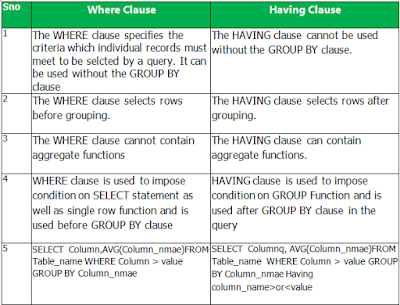
HAVING is same as the WHERE clause but is applied on grouped records. Which SQL statement is faster? Difference between Having and Where. SQL is the Structured Query Language that is comprehensive or declarative in nature and used to access data from databases. In SQL and database interview questions, one of the most asked questions by beginners is how Where and Having clause are different in SQL.
Since programming language usually needs more. Note: It is not a predefined rule but in a good number of the SQL queries, we use WHERE prior to GROUP BY and HAVING after GROUP BY. The Where clause acts as a pre filter where as Having as a post filter. It works in a similar way as WHERE clause and we use it to define a condition.
There are important differences between the two clauses. Let me explain the differences between SQL HAVING and WHERE. HAVING clause is a special type of SQL command.

Der Abfrage- und Sicht-Designer entfernt die Bedingung aus der HAVING -Klausel in der SQL -Anweisung und fügt sie der WHERE-Klausel hinzu. Der SQL Befehl HAVING kann man als WHERE des GROUP BY bezeichnen. HAVING folgt immer dem GROUP BY, kann also nicht davor stehen. Mit HAVING kann man die Ausgabe auf.
SQL HOME SQL Intro SQL Syntax SQL Select SQL Select Distinct SQL Where SQL An Or, Not SQL Order By SQL Insert Into SQL Null Values SQL Update SQL Delete SQL Select Top SQL Min and Max SQL Count, Avg, Sum SQL Like SQL Wildcards SQL In SQL Between SQL Aliases SQL Joins SQL Inner Join SQL Left Join SQL Right Join SQL Full Join SQL Self Join SQL. Before we go any further let’s review the format of an SQL Statement. SELECT FROM WHERE GROUP BY HAVING. To help keep things straight I like to think of the order of execution of SQL statements as from top to bottom. That means the WHERE clause is first applied to the result and then, the remaining rows summarized according to the GROUP BY.

Having vs Where Clause in SQL The difference between the having and where clause in SQL is that the where clause cann ot be used with aggregates, but the having clause can. The where clause works on row’s data, not on aggregated data. The having is an SQL clause that specifies that an SQL select statement should only return rows where aggregate values meet the specified conditions. Combination of SQL HAVING and WHERE We can obviously combine WHERE and HAVING. The SQL above will not work, because the where clause doesn’t work with aggregates – like sum, avg, max, etc.
Instea what we will need to use is the having clause. The having clause was added to sql just so we could compare aggregates to other values – just how the ‘where’ clause can be used with non-aggregates. First we need to filter out all the product codes having value greater than 1and then sum up sale by ID. Then keep only those IDs having sum.
You can use the WHERE clause with groups as well. But there are some differences when writing SQL HAVING vs WHERE clauses. Let’s say you wanted to find the SUM of salaries per department.
SQL HAVING klauzule je speciálním druhem SQL příkazu, který se chová podobně jako jako WHERE. To znamená, že pomocí ní definujeme omezující podmínku při vyhledávání nebo manipulaci s tabulkami. Mezi oběma klauzulemi jsou ale významné rozdíly. Pojďmě si tedy SQL HAVING vs WHERE odlišnosti popsat.
HAVING filters records that work on summarized GROUP BY. HAVING applies to summarized group records, whereas WHERE applies to individual records. HAVING requires that a GROUP BY clause is present.
WHERE Clause helps you to filter out records based on the data available in a Database tablre.
Keine Kommentare:
Kommentar veröffentlichen
Hinweis: Nur ein Mitglied dieses Blogs kann Kommentare posten.